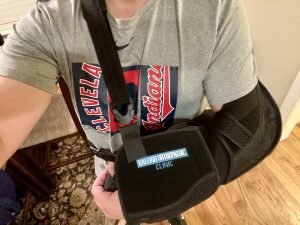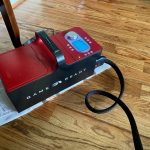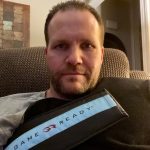Brian Schiff’s Blog
Injury Prevention, Sports Rehab & Performance Training Expert
The last two weeks I have continued to see progress with my strength. My “shrug sign” lifting up my left arm is improving and now most noticeable when lifting my arm out to the side at 80 degrees and beyond. I have seen a steady increase in lifting capacity for my biceps and triceps but am still down more than 50% compared to my right side overall in strength.
New accomplishments
- Able to reach behind my head and wash my hair
- Able to drive and turn the steering wheel with just my left arm
- Begin wall push-ups and single arm rows
Remaining limitations
- Reaching up behind my back
- Unable to lay/sleep on left side
- Decreased elevation and external rotation
I have learned that the shoulder is still vulnerable if I do too much activity or push it too hard with the stretching. Generally, I stick to no more than 4/10 pain when doing passive stretching myself. In therapy, I have been just trying to block out the pain and endure the stretching even when it goes beyond that level. Last week, I had difficulty sleeping the same night following both of my PT sessions. I felt as if the PROM performed by the PT was more intense than it has been. While I was able to tolerate it during the session, the shoulder was increasingly sore and tight the same day after both sessions.
For all those following along with my journey, I have moved just past the 8 week post-op mark. I am pleased to report that I continue to see small steady improvements with my mobility during day-to-day activities as long as I am moving below shoulder height. I continue to have periodic and general low-level soreness at times (intermittent) but no marked pain unless really pushing my motion with stretching.
MD Follow-up
I recently saw the surgeon between weeks 6 and 7. He examined the shoulder and determined everything seemed to be progressing fine. I explained to him that I felt my passive range of motion (particularly flexion) felt limited by a pinching pain along the front of the shoulder in PT and at home. I also just felt that the shoulder was more stiff than I had hoped it would be at this point. He recommended giving me a steroid injection to help with inflammation and mobility. He assured me it would in no way compromise the repair.
See the article abstract below regarding early AROM after surgery:
https://pubmed.ncbi.nlm.nih.gov/31084488/
This was my first experience with cortisone. Patients have always told me 1 of 3 things:
- It’s magic and now all the pain is gone
- It hurts more initially but eventually after a few days they noticed some relief
- It did NOT help at all
The response for me was more in line with answer #2. The posterior shoulder was very sore within 2-3 hours after the injection, and the shoulder felt very heavy the rest of the day (motion actually seemed worse). In 24-36 hours, that pain and heaviness subsided, and I would say I could move the shoulder somewhat better in 72 hours. Since the injection, I have not had the pinching pain, and the motion seems to be getting better gradually. With that said, I still have some discomfort at times and a long way to go to recover all my motion as expected at this phase of the rehab process.
I passed a major milestone last Thursday as I hit the 6 week post-op mark. I have been transitioning out of the sling since week four (at home) while continuing to use the sling out in public. I officially quit using it last week. Things have been progressing, but two words really define the recovery so far: slow and incremental.
Being patient is no easy task when I am so used to working in the clinic, lifting weights and playing sports with my boys. Sleeping has still been a bit of a challenge as the shoulder aches after a few hours in one position, but I am now sleeping in my bed for 6-7 hours with only 2 disturbances per night. My mobility with dressing, shaving, showering and getting dressed is steadily improving. With respect to pain, it is absent at rest. However, it still strikes when I move the wrong way or happen to lift the arm against gravity due to weakness and stiffness.
Rehab
I have been going twice per week, but missed last week due to a summer vacation. I was diligent with my exercises 2x/day while away. Prior to leaving, my latest passive range of motion was equal to 117 degrees of flexion and 38 degrees of external rotation at 5 weeks post-op. As far as guidelines for the next 2-4 weeks, the goals are to restore ROM, resolve pain and begin light strengthening with rehab activities such as:
- Begin active assistive range of motion (AAROM) progressing to active range of motion (AROM)
- Continue with deltoid and rotator cuff isometric strengthening
- Begin light scapular strengthening – retraction (light rows), protraction (serratus anterior work), scapular depression and gentle ball stabilization work in a dependent position
- AAROM exercises with a dowel rod or cane (external rotation, extension, scaption, flexion, horizontal adduction/abduction)
- Joint mobilization, continued passive stretching to restore full range of motion and addition of shoulder pulley in this phase
- Light biceps and triceps strengthening (elbow at side)
- Scar massage
One important note: I have found the continued use of ice helpful in reducing daily soreness and discomfort following my home program. As such, I would highly recommend its daily use this late into the rehab.
Last week I began sharing my story about my left arthroscopic rotator cuff repair. As reminder, I had surgery on May 20. In this post, I will share more about the first week. I get many common questions like: How bad does it hurt? When can you get rid of the sling? How long is the total recovery?
The entire outpatient procedure went well. I barely remember getting an interscalene block (kudos to the anesthesiologist) and the entire operation lasted about 45 minutes. The oldest feeling is not feeling the left arm and having no control of the arm until the block wears off. The entire arm is essentially paralyzed and numb. Great for pain management to be sure, but not even being able to use the hand is inconvenient for small prehensile tasks.
I was fortunate that I did not have any adverse reaction to the anesthesia itself. I was a bit tired and groggy for the first 4-6 ours after surgery. The biggest adjustment is getting used to the sling and abduction pillow (see below)

Learning how to sit, adjust and take this off/put it on takes some getting used to. However, I quickly learned how valuable and supportive it was once the block wore off. My surgery was at 8:45 AM on a Thursday. The block wore off about 18 hours later at 3 AM. Let’s just say that aha moment was enough to get my attention.
Pain
I would say pain level was 7/10 for me. The doctor and his staff had advised me to start taking pain pills ahead of the block wearing off and I had initiated that about 8 hours after surgery. I was alternating ibuprofen every 2 hours while taking oxycodone every 4 hours. I can only imagine how much more it would have hurt if I had waited for the block to wear off.
Cryotherapy
The first 3-4 days afterward were the worst in terms of pain. Generally, pain at rest was probably 3-4/10, occasionally spiking to 9/10 if I moved the wrong way. Aside from the meds, I used cryotherapy, specifically a Game Ready, extensively (20 minutes on, 40 minutes off) 8-10 times per day the first week. I cannot say enough about how helpful this is in managing pain and inflammation.
- Game Ready unit
- Shoulder sleeve
This unit provides cold and compression, however, I would recommend low or no compression initially as your incisions will be tender, especially once the surgical dressing is removed at day 3 post-op. I sat upright in a chair and supported the elbow while using this machine. The hospital or outpatient facility will offer a polar care unit for $250, but I opted for this unit as I have used it for years in the clinic, while hearing countless patients tell me how much better it is. A 3-week rental will cost you $300, but it is well worth it.
The Backstory
It all began with a burning sensation in my left shoulder in November 2020 with a simple gesture. I did not give it a second thought, as it subsided in a few minutes. However, I soon began to notice more regular pain with certain movements and difficulty sleeping at night. Honestly. I thought it would subside and chalked it up to some mild rotator cuff inflammation. For years, I had avoided overhead lifts and heavy bench press, while restricting range of motion to reduce stress on my shoulders. With that said, this pain led to me further modifying my workouts.
A few weeks later, the nocturnal pain became more intense and prevalent. I knew it was time to formally rehab my shoulder. So, I did what I would advise my patients to do. I embarked on 6 weeks of rotator cuff and scapular strengthening 3x/week, while using laser, ice, and non-steroidal anti-inflammatory meds to resolve the pain. I stuck religiously to this plan from mid December to the end of February. Unfortunately, nothing helped. Sleeping was interrupted consistently, and my function was limited.
As such, I sought the counsel of a trusted surgeon I work closely with. He ordered an MRI, which revealed a 1 cm near full-thickness tear in the supraspinatus tendon, a type II acromion and a big anterolateral bone spur. As you can see from the list below, I have a borderline medium-size tear.
Rotator Cuff Tear Classification:
Small < 1 cm
Medium 1-3 cm
Large 3-5 cm
Massive > 5 cm



